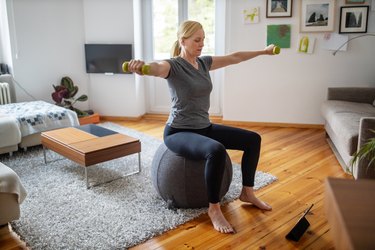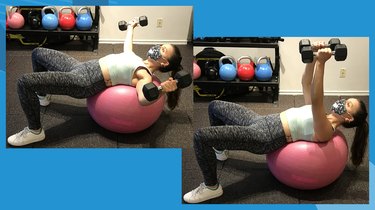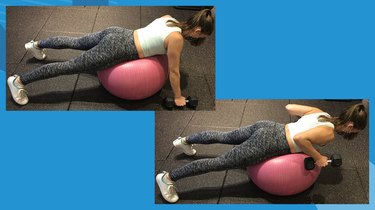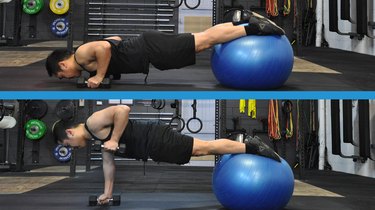
Stability balls and dumbbells are a staple in many home gyms, and with good reason! They're incredibly versatile and effective strength-training tools. And combining the two is a great way to get results fast. Not to mention, the stability ball can conveniently stand in for an exercise bench.
Whether you call it a stability ball, balance ball or Swiss ball, adding this piece of equipment to your routine is a great way to take your workouts to the next level.
Video of the Day
Video of the Day
"The stability ball will almost always increase the difficulty of an exercise," Grayson Wickham, DPT, CSCS, founder of Movement Vault, tells LIVESTRONG.com. That's because it increases the demand on your stabilizing muscles, including your hips, ankles and core, he says.
And Sergio Pedemonte, CPT, owner of Your House Fitness, says he often uses stability balls and dumbbells together for a few reasons. "The best part about these pieces of equipment is that they are easy to store and transport and are often an inexpensive way to work out at home."
How to Safely Combine Dumbbells and a Stability Ball
If you're just starting out, make sure you can perform the dumbbell exercises with good form without the ball first, Wickham says.
"Next, make sure you can perform the exercise with good form on the stability ball without any dumbbells or weights added," he says. "Once you have those two progressions mastered, you can add light dumbbells to the exercise and slowly increase the weight while maintaining good form."
As far as the weight of the dumbbells, you want to pick a weight that challenges you but that you can maintain good form with for 8 to 15 reps. And don't increase the weight of your dumbbells until you've mastered the exercise on the stability ball with good form at your current weight, Wickham says.
"Typically, you will not go extremely heavy with your dumbbell weight using a stability ball," he says.
Tip
Stability balls come in a wide variety of sizes. To make sure it's the correct size, your knees should be at a right angle when sitting on the ball with your feet flat on the floor, according to the Mayo Clinic.
Also, be aware that the amount of air pressure in the ball changes the level of difficulty. Beginners should use a softer ball that gives you a wider base to sit on, while a firmer ball is for those accustomed to this type of training.
Try These 5 Stability Ball and Dumbbell Exercises
Pedemonte recommends doing chest presses, shoulder presses, triceps extensions and deltoid rows. "Each of these exercises are great to perform on their own on a bench, however, adding a stability ball will challenge your core even further and increase balance from the additional recruitment of the stabilizing muscles."
Ready to get started? Here are 5 trainer-approved exercises using a stability ball and a pair of dumbbells for a great total-body workout.
1. Stability Ball Shoulder Press

- Sit on the stability ball with your feet flat on the floor and your back straight.
- Hold a dumbbell in each hand at your shoulders, elbows bent out to the sides and palms facing forward.
- Straighten your elbows and press the dumbbells up into the air over your head.
- Return to the starting position by bending your elbows.
Tip
“The stability ball shoulder press is an effective exercise for increasing strength in both the shoulder and upper back,” Pedemonte says. A wider stance will give you more stability while sitting on the ball, while a more narrow stance is more challenging, according to the American Council on Exercise (ACE).
2. Stability Ball Chest Fly

- Rest your shoulder blades on the stability ball, with your knees bent and your feet flat on the floor.
- Contract your abs to keep your hips lifted throughout the exercise.
- Start by lifting arms straight up and over your chest, palms facing each other. This is the starting position.
- Draw your shoulder blades together as you move your arms out to each side, keeping palms facing each other and your elbows slightly bent.
- Keep the movement slow and controlled as you bring your arms down, then use your chest and arm muscles to return to the weights to the starting position.
Tip
Pedemonte explains that this exercise not only strengthens your chest, triceps and shoulders, but it also really works your core.
3. Stability Ball Row

- Lie on your stomach with your hips on the stability ball and your toes on the floor behind you.
- Draw your shoulder blades together slightly so they're in line with your hips.
- Raise the dumbbells up to the sides of your chest as you bend your elbows.
- Slowly lower your arms down together in front of you.
Tip
“This exercise will increase muscular strength in the posterior deltoid [the part of your shoulder muscle in your upper back], as well as muscles in the rotator cuff and upper back,” Pedemonte says.
4. Stability Ball Triceps Extension

- Lie on your stomach with your hips under the ball and chest raised slightly off the ball. Your legs should be straight behind you with your toes on the floor.
- Tighten your core and keep your shoulders and back straight. Draw your shoulder blades together as you draw the weights up to the sides of your chest. This is the starting position.
- Extend your elbows straight until your arms are parallel to the sides of your body.
- Return to the starting position by bending at your elbows.
5. Push-Up Renegade Row

- Place your feet on the ball, as you get into a high plank with a dumbbell in each hand.
- Tighten your abdominal muscles and keep your body in a straight line. No sagging at the hips!
- Perform a push-up by bending your elbows and lowering your chest toward the floor.
- Press back up and row one weight to your shoulder.
- Set the weight back down and perform another push-ups. This time, row the other weight to your shoulder at the top.
- Contine to alternate sides between push-ups.
Tip
This exercise is great for those looking to challenge themselves, says Michael Julom, ACE-certified personal trainer and founder of ThisIsWhyImFit.com. He says this tough core exercise works your internal obliques (at the sides of your torso) isometrically (without movement), while also building up the muscles of your upper back.
“The pressure into the shoulder girdle and pectorals makes for fantastic stability assistance through the entire upper body,” he says.
Was this article helpful?
150 Characters Max
0/150
Thank you for sharing!
Thank you for your feedback!